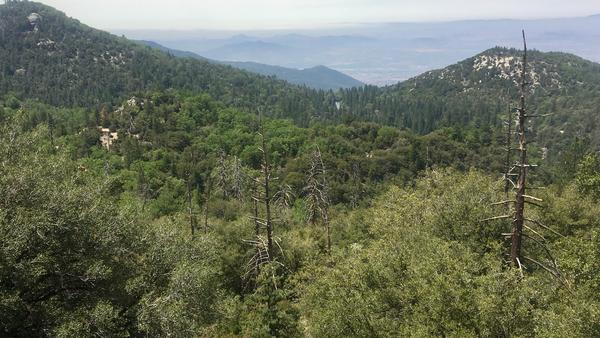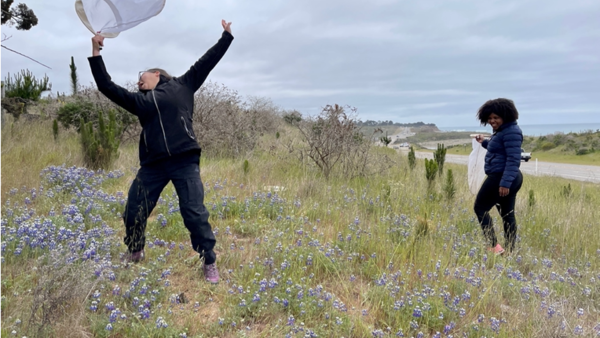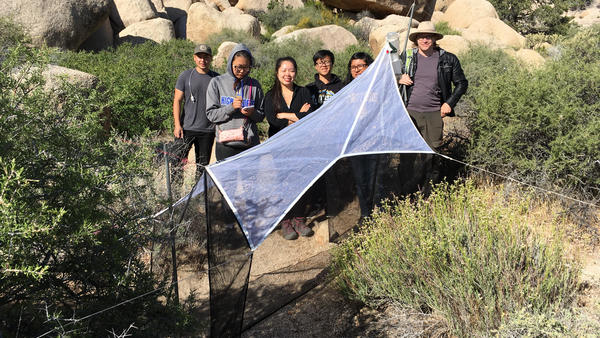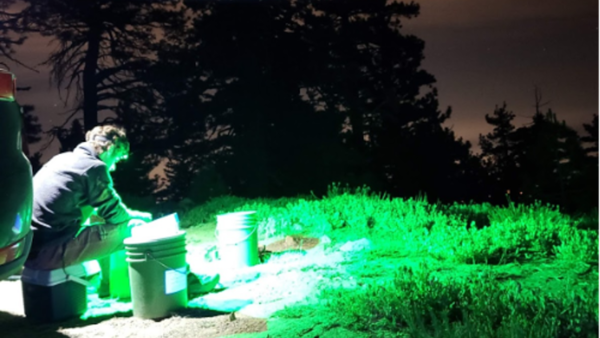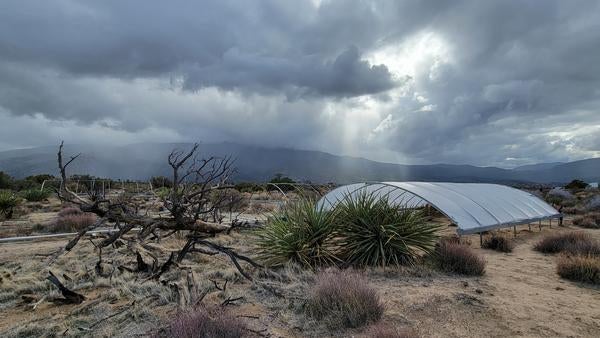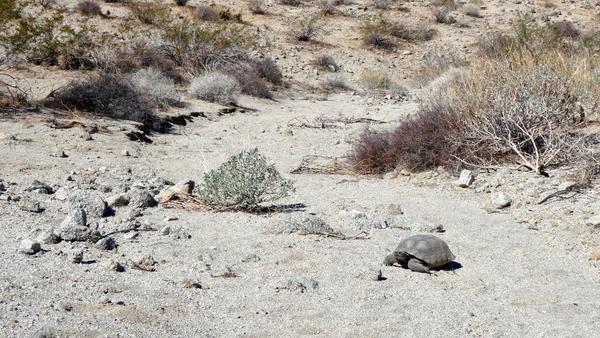Past Projects
UCR Natural Reserve System Summer Internship
A. Forest Dynamics
Mentor: Dr. Marko Spasojevic
Forests play key roles in biodiversity maintenance and climate regulation. Globally, forests support over half of all described species and provide many valuable ecosystem functions and services such as timber, clear air, clean water, and carbon storage. However, forests worldwide are being threatened by habitat loss, drought, and changing fire regimes, which have all resulted in losses to biodiversity and alterations to key ecosystem functions and services. Understanding and predicting how forests will respond to ongoing and pervasive changes to the environment is critical for biodiversity conservation and for the management and maintenance of ecosystem services. To address this, the Spasojevic Ecology lab at UC-Riverside has established a 4ha Forest Dynamics Plot (FDP) adjacent to the James Reserve. Briefly, within the FDP every free-standing woody stem (live or dead) greater than 1cm in diameter has been identified to species, mapped, measured, and tagged for long term monitoring. In establishing this plot, we have observed that many of the Conifers are dead or dying and that there are few Conifers recruiting into this forest. On the other hand, very few Oaks have died and there are many Oaks recruiting into the forest. These patterns suggest a potential shift in the composition of the forest from a mixed Oak-Conifer Forest to a more Oak dominated system. This change in the composition of the forest can have important ramifications for carbon storage, as Oaks are slower growing than Pines, as well as implications for the rest of the plants and animals that depend on these species. We are seeking an intern that is interested in plant ecology and climate change who is seeking to gain field experience (spending at least 50% of their research time in the field).
B. Bumblebees of the UC Natural Reserve System
Mentor: Dr. Hollis Woodard
Bumble bees are important pollinators in many natural and agricultural systems, but many species within the group are declining and face potential extinction. Improving our understanding of where they are found and patterns of genetic diversity within species are both critical to conserving bumble bees. This project will examine bumble bees of the UC Natural Reserve System. After participating in a remote training workshop to learn about bumble bee identification and field methodology, the student will travel to UC Reserves to carry out surveys and perform targeted bee collections that will be used for genome sequencing. This internship will support (1) the new California Bumble Bee Atlas Project (www.cabumblebeeatlas.org), which is a partnership between the Xerces Society for Invertebrate Conservation and the California Department of Fish and Wildlife, and (2) the California Conservation Genomics Consortium http://www.ccgproject.org, a state-funded consortium of 100+ conservation scientists from across the state of California working to generate genome sequences for rare and threatened species. Time will also be spent working in the Woodard lab at UC Riverside, assisting with bumble bee experiments. The intern will receive training in field research methods and safety, bee identification, conservation biology, genomics, and experimental biology.
C. Ecology of Stephen's Kangaroo Rat
Mentor: Dr. Loralee Larios
The Motte Rimrock Reserve is critical habitat for the threatened Stephens' Kangaroo Rat (SKR). This small rodent is an important component of the local grassland and coastal sage scrub habitat. It's foraging has strong impacts on plant community composition. For this project, the intern will work with the Larios lab in collaboration with the staff at the Motte Rimrock reserve to explore the ecology of this species. The project will contain a mix of data analysis and field work.
D. Biodiversity Survey of Heteroptera and Parasitic Hymenoptera at UC Reserves
Mentors: Dr. Christiane Weirauch and Dr. John Heraty
Insects are the most diverse group of eukaryotic organisms. Our UC Reserves cover a wide range of ecosystems across the California Floristic Province biodiversity hotspot. However, the insect fauna of these reserves is still severely understudied. This is particularly true for insect groups where individuals are small and where many species are still unknown to science. We are looking for interns that would help to sample and curate two very diverse groups, the Heteroptera (true bugs) and Hymenoptera (specifically parasitoid wasps). This project will use a variety of collecting techniques (Malaise traps, yellow pan traps, sweeping vegetation, etc.) at multiple reserves (Granite Mountains, James Reserve, Emerson Oaks, Motte Rimrock) to survey these insects. Specimens will be sorted to morphospecies and imaged at UCR to become part of a large barcoding initiative for insects across all of California. A goal of this project is to get an initial assessment of species richness at each of the four sites. Interns will gain experience in the recognition of insect families, collecting techniques, curation of insect material, databasing and the basics of molecular sequencing.
E. Effects of Climate Change on Diurnal and Nocturnal Insect Diversity and Pollination Interactions
Mentor: Dr. Nicole Rafferty
The Rafferty Lab—in the Evolution, Ecology, and Organismal Biology Department at UC Riverside—is seeking a UC NRS Intern to do research at the Boyd Deep Canyon Desert Research Center, where a current project in the lab examines the effects of climate change on diurnal and nocturnal insect diversity and pollination interactions. Field work would take place along a steep elevational gradient that begins near the main Boyd station in desert habitat, continues up through chaparral and pinyon-juniper woodland, and ends atop the Santa Rosa Mountains in conifer forest habitat. The intern would work closely with graduate students to assist with both field and lab work. Training will be provided in tasks ranging from collecting insects, recording plant-visitation, and surveying flowering phenology in the field, to pinning and identifying insects, organizing data, and performing analyses using R software in the lab. The independent research project can make full use of the previous two years of data from these field sites, in addition to any data the intern collects. Potential research project topics include those focused on plant and/or insect ecology (e.g., pollination), projects specific to desert, chaparral, and forest habitats, and elevational trends in insects and/or plants. Work can be divided between field and lab depending on the student’s preference. Field sites are no more than two hours drive from the UC Riverside campus, and transportation can be shared. Field trips often involve overnights in remote camping conditions, and hiking off-trail in uneven terrain.
F. Understanding Drought Through Rainfall Manipulation Experiments
Mentor: Dr. Pete Homyak
Nitrogen emissions from soils (N2, NOx, and N2O) are products/byproducts of biological processes and are often ignored in ecosystem nutrient budgets. However, soil N gas fluxes are an important pathway for ecosystem nutrient loss, particularly in regions with strong seasonality such as California, whose Mediterranean climate produces strong temporal gradients in soil moisture. Furthering understanding of the mechanisms that control soil N emissions is important for modeling N pollution at a global scale since semiarid ecosystems account for 1/3 of the land surface and 25% of global soil NO emissions.
Our lab is quantifying the significance of gaseous N pathways, by linking biological processes with periods of stress to soil microbes (drought), and by understanding how legacies of past precipitation affect N emissions and N cycling.
To understand mechanisms of gaseous N production, we integrate both C and N measurements with isotopic tools in both field and laboratory experiments. The student will mainly be working with data that was collected in the field, with opportunities to visit the rain manipulation experimental plot at Boyd Reserve.
G. Ecology of Desert Tortoises in the Southern Coachella Valley
Mentor: Dr. Chris Tracy, Dr. Bill Hoese & Dr. Jeffrey Lovich
Desert tortoises (Gopherus agassizii) are an iconic species that live throughout the Mojave and Sonoran Deserts. The burrows of this federally threatened species provide shelter for a wide range of species, including birds, mammals, and other reptiles. The population of desert tortoises south of the Coachella Valley is isolated from the rest of the species range, and occurs both at the edge of the species range and a lower elevations than are typical for the species. However, few studies have worked with these tortoises. Because low desert elevations tend to be relatively hotter and drier, tortoises in this area may lend insights into how tortoises elsewhere will have to cope with climate change. This ongoing project will involve monitoring activity at tortoise burrows in the Boyd Deep Canyon Reserve (near Palm Desert), and may involve a number of techniques and collaborators. Camera traps have been set at several known burrows to monitor tortoise activity and burrow use by other species. This summer, we will also be attaching radio transmitters to tortoises to monitor their movements and other behaviors. The intern will have opportunities to develop wildlife skills that may open doors for future jobs in conservation biology. The project may involve maintaining camera traps, viewing videos from the traps and extracting data from them, data analysis, radio tracking of tortoises, finding new burrows, and observing tortoise behaviors in the wild. The project will involve several trips to the Deep Canyon Reserve that might include overnight stays. It will require hiking rough desert terrain during the summer, when temperatures will often be over 100°F. The intern will be working primarily at the Deep Canyon Reserve with researchers from the US Geological Survey Biological Division, UCR, and Cal. State Fullerton to help understand tortoise behaviors in this understudied population, as well as use of tortoise burrows by tortoises and other species.
